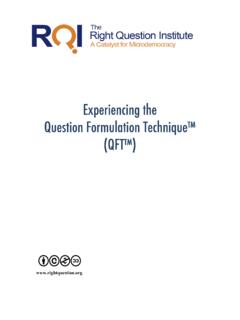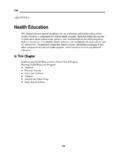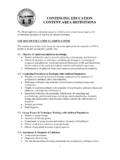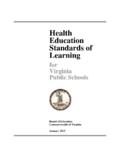Transcription of Concept-based teaching and learning Physical and …
1 IB position paper Physical and health Concept-based education teaching guide and learning (pilot). H Lynn Erickson For use from September 2014 or January 2015. Concept-based teaching andOrganization International Baccalaureate learning 2012 1. Introduction to IB position papers This paper is part of a series of papers, written by IB practitioners and endorsed by the IB. Each paper addresses a topic or issue related to the IB's philosophy or its educational practices. Other papers in the series Allan, M. May 2011. Thought, word and deed: The roles of cognition, language and culture in teaching and learning in IB World Schools.
2 Davy, I. July 2011. Learners without borders: A curriculum for global citizenship. Hare, J. July 2010. Holistic education : An interpretation for teachers in the IB programmes. Marshman, R. July 2010. Concurrency of learning in the IB Diploma Programme and Middle Years Programme. Walker, G. October 2010. East is East and West is West. Concept-based teaching and learning 2. Abstract This paper examines the characteristics of Concept-based curriculum and instruction models and identifies the International Baccalaureate (IB) programmes as a three-dimensional, Concept-based model. A discussion of the benefits of Concept-based instruction supports the majority of attributes in the IB learner profile.
3 Concept-based instruction requires an understanding of synergistic thinking, transfer of knowledge and social construction of knowledge. This paper addresses these areas and discusses them in the context of the required IB pedagogy. It concludes with a review of the challenges in implementing a Concept-based model and a summary of the rewards. Introduction The International Baccalaureate programmes offer a design for curriculum and instruction that is more challenging than traditional models, but which can produce deeper intellectual and emotional engagement in learning . The Concept-based design is fully supported by cognitive and learning research.
4 When information today is a click away on a computer keyboard, the use of classroom time must shift focus from covering and memorizing information to thinking with and applying knowledge at both the factual and conceptual levels. Thinking deeply with factual knowledge and concepts to communicate ideas and solve problems, transferring knowledge across distinct global contexts and situations, and seeing patterns and connections between concepts, ideas and situations are at the heart of Concept-based teaching and learning . Less factual coverage can open the door to deeper thinking and understanding.
5 What is Concept-based curriculum and instruction? Concept-based curriculum and instruction is a three-dimensional design model that frames factual content and skills with disciplinary concepts, generalizations and principles. Concept-based curriculum is contrasted with the traditional two-dimensional model of topic- based curriculum which focuses on factual content and skills with assumed rather than deliberate attention to the development of conceptual understanding and the transfer of knowledge (see Figure 1). Concept-based teaching and learning 3. Figure 1. Two-dimensional and three-dimensional curriculum and instruction (taken from Erickson 2008).
6 Two-dimensional curriculum models focus on facts and skills with the goals of content coverage, analysis and the memorization of information. Three-dimensional models focus on concepts, principles and generalizations, using related facts and skills as tools to gain deeper understanding of disciplinary content, transdisciplinary themes and interdisciplinary issues, and to facilitate conceptual transfer through time, across cultures and across situations. Three-dimensional models value a solid base of critical factual knowledge across the disciplines, but they raise the bar for curriculum and instruction by shifting the design focus to the conceptual level of understanding.
7 This focus necessarily requires a supporting role for factual knowledge. A corollary goal of Concept-based instruction that is seldom stated overtly is development of the intellect. In a Concept-based instruction model teachers use the facts in concert with concepts and generalizations to effect higher order, synergistic thinking. Facts provide the foundation and support for deeper, conceptual thinking and understanding. Three-dimensional Concept-based curriculum models value student inquiry and constructivist learning to support personal meaning-making. The research and agreement on the importance of conceptual understanding is undeniable.
8 From the National Council of Teachers of Mathematics (NCTM) (2009) we hear the call: Any national mathematics curriculum must emphasize depth over breadth and must focus on the essential ideas and processes of mathematics (p 1). research on the learning of complex subjects such as mathematics has solidly established the important role of conceptual understanding in the knowledge and activity of persons who are proficient (p 2). One of the strongest research summaries supporting the importance of conceptual understanding can be found in How People Learn: Brain, Mind, Experience and School (Bransford et al 2000), published by the National Academy of Sciences and the National Research Council.
9 Experts' knowledge is connected and organized around important concepts (eg, Newton's second law of motion) (p 9). To develop competence in an area of inquiry, students must: a) have a deep foundation of factual knowledge, b) understand facts and ideas in the context of a conceptual framework, and c) organize knowledge in ways that facilitate retrieval and application (p 16). Concept-based teaching and learning 4. organizing information into a conceptual framework allows for greater transfer; that is, it allows the student to apply what was learned in new situations and to learn related information more quickly (p 17).
10 Anderson and Krathwohl's book (2001) updated Benjamin Bloom's Taxonomy of Educational Objectives (1956), and further supports the need to teach for deeper conceptual understanding. By separating factual knowledge from conceptual knowledge, we highlight the need for educators to teach for deep understanding of conceptual knowledge, not just for remembering isolated and small bits of factual knowledge (p 42). Students understand when they build connections between the new . knowledge to be gained and their prior knowledge. More specifically, the incoming knowledge is integrated with existing schemas and cognitive frameworks.










